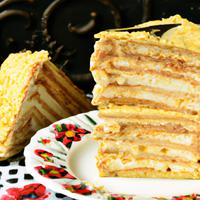
1 serving (100 grams) contains 300 calories, 4.0 grams of protein, 15.0 grams of fat, and 40.0 grams of carbohydrates.

Log this food in SnapCalorie

Nutrition Information
Calories |
721.2 | ||
|---|---|---|---|
% Daily Value* |
|||
| Total Fat | 36.1 g | 46% | |
| Saturated Fat | 19.2 g | 96% | |
| Polyunsaturated Fat | 0 g | ||
| Cholesterol | 120.2 mg | 40% | |
| Sodium | 480.8 mg | 20% | |
| Total Carbohydrates | 96.2 g | 34% | |
| Dietary Fiber | 2.4 g | 8% | |
| Sugars | 60.1 g | ||
| protein | 9.6 g | 19% | |
| Vitamin D | 0 mcg | 0% | |
| Calcium | 120.2 mg | 9% | |
| Iron | 3.6 mg | 20% | |
| Potassium | 240.4 mg | 5% | |
* Percent Daily Values are based on a 2,000 calorie diet. Your daily values may be higher or lower depending on your calorie needs.
Food Attributes
Source of Calories
About Slice of layered cake
A slice of layered cake is a classic treat often enjoyed worldwide and varies by cuisine. Crafted with alternating layers of moist cake and creamy filling or frosting, it typically includes ingredients like flour, sugar, eggs, butter, and flavorings such as vanilla or cocoa. Some variations may incorporate fruits, nuts, or spices for added texture and flavor. This indulgence is most commonly associated with European baking traditions but is celebrated globally in various forms. While layered cake offers a delightful sensory experience, it is generally high in sugar, saturated fats, and calories, making it a less healthy option when eaten frequently. However, some recipes incorporate whole grains, natural sweeteners, or fresh ingredients, which can slightly boost its nutritional profile. Moderation is key to enjoying this decadent dessert without detracting from a balanced diet.



